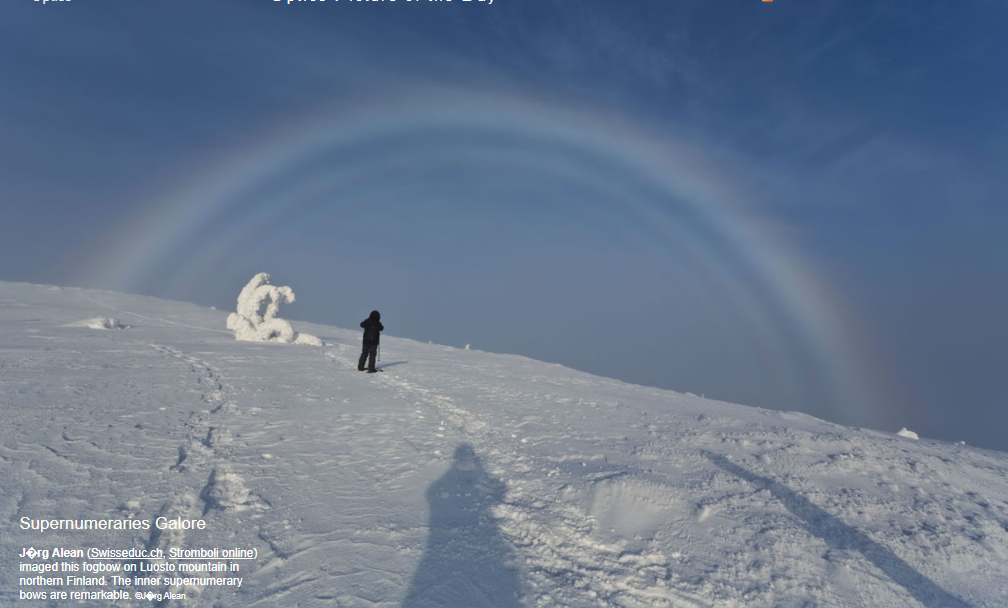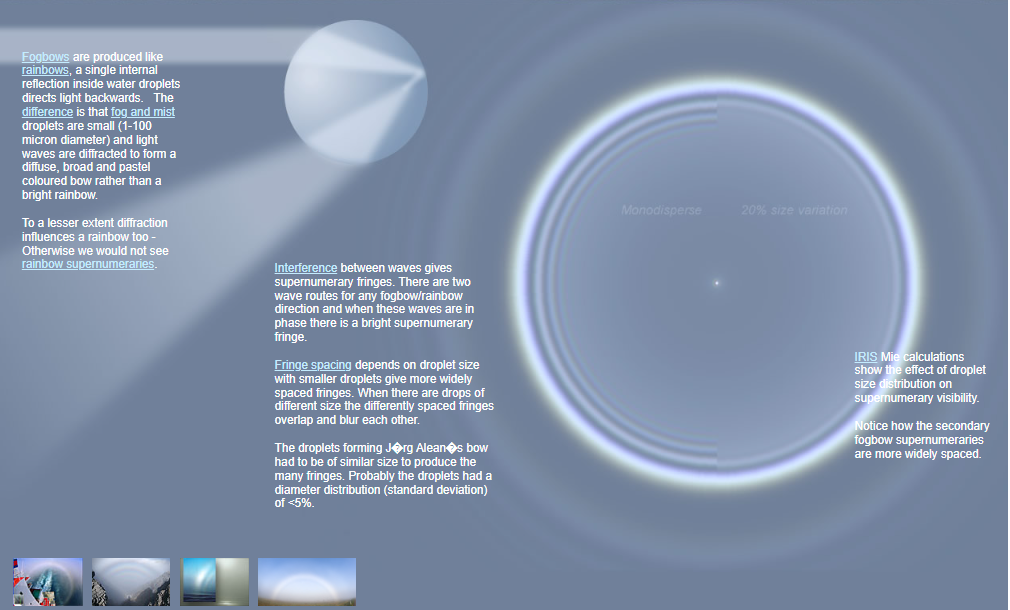OPOD - Finland Fogbow
OPOD - Finland Fogbow: A Mesmerizing Display of Atmospheric Optics
Fogbows, similar to rainbows, are a captivating phenomenon that occurs when light interacts with water droplets in the atmosphere. However, there are distinct differences between the two. While rainbows appear as bright and vibrant arcs, fogbows are characterized by their diffuse, broad, and pastel-colored appearance. In this article, we will explore the mesmerizing Finland Fogbow captured by Jörg Alean and delve deeper into the science behind this atmospheric optical marvel.
The Science Behind Fogbows
Fogbows, like rainbows, result from the refraction and reflection of sunlight within water droplets. However, the key distinction lies in the size of the droplets. Fog and mist droplets are considerably smaller, ranging from 1 to 100 microns in diameter. These tiny droplets diffract light waves, causing the formation of a fogbow that appears more ethereal and less defined than a rainbow.
The Role of Diffraction and Interference
While diffraction plays a minor role in the formation of rainbows, it significantly influences the appearance of fogbows. Diffraction refers to the bending of light waves as they pass around obstacles or through narrow openings. In the case of fogbows, diffraction causes the light waves to spread out and form a broad and diffuse bow.
Interference between waves further enhances the visual spectacle of fogbows. When there are two wave routes for light traveling through fog or mist droplets, these waves can either reinforce or cancel each other out. The reinforcement creates bright supernumerary fringes within the fogbow.
The Enigmatic Supernumerary Fringes
Supernumerary fringes are the additional bands of color observed within a fogbow or rainbow. These fringes arise from the interference between waves following different paths within the water droplets. The spacing of these fringes is determined by the size of the droplets, with smaller droplets resulting in more widely spaced fringes.
Interestingly, when droplets of different sizes are present, the fringes overlap and blur each other, creating a mesmerizing blend of colors. In the case of Jörg Alean's Finland Fogbow, the multitude of supernumerary fringes indicates that the droplets responsible for its formation were likely of similar size, possibly with a diameter distribution of less than 5%.
Unveiling the Beauty with IRIS Mie Calculations
To better understand the influence of droplet size distribution on the visibility of supernumerary fringes, researchers employ sophisticated calculations. IRIS Mie calculations allow scientists to simulate the effect of varying droplet sizes on the appearance of fogbows. By analyzing these simulations, researchers can gain insights into the intricate mechanisms at play and unravel the mysteries behind these captivating atmospheric phenomena.
A Closer Look at Jörg Alean's Finland Fogbow
The Finland Fogbow captured by Jörg Alean on Luosto mountain in northern Finland is a stunning example of this elusive optical phenomenon. The inner supernumerary bows observed in Alean's photograph are particularly remarkable, showcasing the intricate interplay of light and water droplets. The diffuse and pastel-colored nature of the fogbow adds to its ethereal beauty, captivating both scientists and nature enthusiasts alike.
Conclusion
Fogbows offer a fascinating glimpse into the intricate workings of atmospheric optics. Their diffuse and pastel-colored appearance, coupled with the presence of mesmerizing supernumerary fringes, creates a visual spectacle that leaves us in awe of nature's wonders. Through ongoing research and advanced calculations, scientists continue to uncover the secrets behind fogbows, shedding light on their formation and further enriching our understanding of the natural world around us. So, next time you find yourself in the presence of a foggy or misty landscape, keep an eye out for the elusive fogbow, and let yourself be captivated by its ethereal beauty.

Supernumeraries Galore
J�rg Alean (Swisseduc.ch, Stromboli online) imaged this fogbow on Luosto mountain in northern Finland. The inner supernumerary bows are remarkable. ©J�rg Alean

Fogbows are produced like rainbows, a single internal reflection inside water droplets directs light backwards. The difference is that fog and mist droplets are small (1-100 micron diameter) and light waves are diffracted to form a diffuse, broad and pastel coloured bow rather than a bright rainbow.
To a lesser extent diffraction influences a rainbow too - Otherwise we would not see rainbow supernumeraries.
Interference between waves gives supernumerary fringes. There are two wave routes for any fogbow/rainbow direction and when these waves are in phase there is a bright supernumerary fringe.
Fringe spacing depends on droplet size with smaller droplets give more widely spaced fringes. When there are drops of different size the differently spaced fringes overlap and blur each other.
The droplets forming J�rg Alean�s bow had to be of similar size to produce the many fringes. Probably the droplets had a diameter distribution (standard deviation) of <5%.
IRIS Mie calculations show the effect of droplet size distribution on supernumerary visibility.
Notice how the secondary fogbow supernumeraries are more widely spaced.
Note: this article has been automatically converted from the old site and may not appear as intended. You can find the original article here.
Reference Atmospheric Optics
If you use any of the definitions, information, or data presented on Atmospheric Optics, please copy the link or reference below to properly credit us as the reference source. Thank you!
-
<a href="https://atoptics.co.uk/blog/opod-finland-fogbow/">OPOD - Finland Fogbow</a>
-
"OPOD - Finland Fogbow". Atmospheric Optics. Accessed on December 22, 2024. https://atoptics.co.uk/blog/opod-finland-fogbow/.
-
"OPOD - Finland Fogbow". Atmospheric Optics, https://atoptics.co.uk/blog/opod-finland-fogbow/. Accessed 22 December, 2024
-
OPOD - Finland Fogbow. Atmospheric Optics. Retrieved from https://atoptics.co.uk/blog/opod-finland-fogbow/.